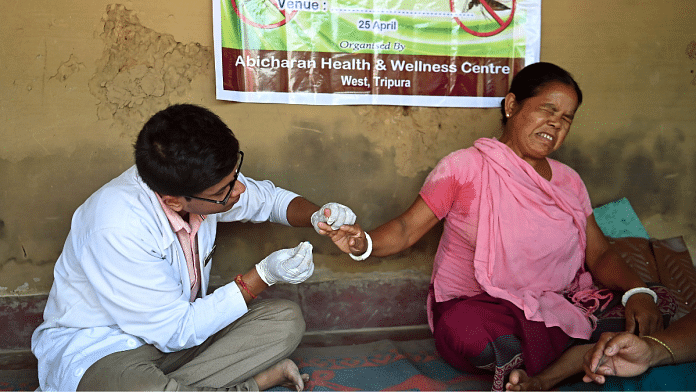New Delhi: Over four years after first drawing up of the National Essential Diagnostics List (NEDL), India’s apex health research agency, the Indian Council of Medical Research (ICMR), this week invited suggestions for revising it, saying such a move is aimed at facilitating the availability of in-vitro diagnostics (IVDs) across the various tiers of the healthcare pyramid.
The Indian Council of Medical Research (ICMR) defines essential diagnostics as tests “that satisfy the priority health care needs of the population, which are selected with due regard to disease prevalence and public health relevance, evidence of efficacy and accuracy, and comparative cost-effectiveness”.
India’s first NEDL, recommended by ICMR and released in 2019, enumerated the minimum number of tests that were to be made available at various levels of healthcare facilities, such as village-level health and wellness centers, primary health centers, community health centers, sub-district hospitals, and district hospitals.
This came a year after the World Health Organization (WHO) recommended the development and implementation of essential diagnostic tests for every country according to their disease burden and priority areas. India was reportedly the first country to draw up this list.
The NEDL was adopted by the Free Diagnostic Service Initiative (FDSI) of the National Health Mission (NHM) to ensure that the diagnostic services provided under the initiative aligned with the essential diagnostic tests.
But in its latest document, issued this week, the ICMR said that since considerable time has elapsed following the release of the first NEDL it needed to be revised — that some tests needed to be added while some could be dropped.
“The test should focus on conditions with a high disease burden or having significant public health relevance, where introduction of diagnostic tests will have a clear impact on disease diagnosis and management,” the health research agency said in its circular inviting suggestions.
ThePrint has reached ICMR’s director general Dr. Rajiv Behl on phone for comment but received no response till the time of publication of this report. The article will be updated if and when a response is received.
Industry insiders called the decision a positive step with the potential to ensure widespread access to advanced diagnostic services, and one that can reduce the impact of diseases on individuals and communities nationwide.
“However, for this initiative to realise its full potential, the focus should be more on increasing healthcare accessibility in smaller towns across India,” Ameera Shah, promoter and managing director of Metropolis Healthcare, an Indian multinational chain of diagnostic labs, told ThePrint.
‘Quality should be sacrosanct’
While the money spent on medical diagnostics accounts for only five percent of total healthcare costs, it influences the remaining 95 percent expenditure, Dr. Navin Dang, founder and director of Dr. Dangs Lab in New Delhi, told ThePrint. He estimates that around 70 percent of medical decisions regarding early disease diagnosis, patient prognosis, and treatment selection are based on laboratory diagnostic results.
“Along with treatment regime selection, diagnostic test results help in monitoring of the patient’s condition during recovery and follow-up, therefore it’s important that all tiers of healthcare facilities should provide the basic diagnostic facilities,” Dr. Dang said.
However, he stressed that when certain test facilities are promised at a particular centre, there should also be provisions for requisite infrastructure, manpower, and resources to ensure seamless operations for the benefit of patients.
“Also, at every centre, there has to have enough volume of essential tests to keep the equipment functional — without a certain daily number of tests, calibrations, and controls go to waste, leading to a compromise in quality and accuracy of the tests,” Dang said, adding that “most importantly, maintaining quality is sacrosanct”.
Priority diseases such as anemia, malaria, tuberculosis, and hypertension should be given utmost importance while choosing diagnostic tests, Dang added.
Shah, who is also the senior vice-president of Nathealth — a network of private healthcare providers in India — underlined that with 99.9 percent of the diagnostic industry currently lacking accreditation, concerns about healthcare service quality in India have surfaced. To enhance patient well-being, it is imperative to establish minimum standards for government testing, making accreditation mandatory, she said.
“This ensures consumer confidence in the quality of services provided,” Shah said, adding that Nathealth endorses the public-private partnership model and advocates for the government’s financial support to globally accredited diagnostic organisations.
Shah further said: “This support will enable these organisations to expand their testing capabilities, contributing to comprehensive and high-quality diagnostic services. Furthermore, we advocate for health insurance to cover outpatient diagnostics. If implemented, this step will significantly enhance affordability and accessibility for consumers.”
(Edited by Uttara Ramaswamy)
Also Read: ICMR wants to develop India-specific growth reference standards for kids. Why this is important



